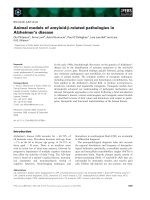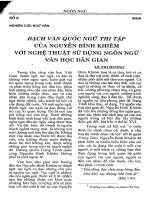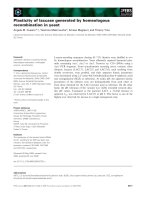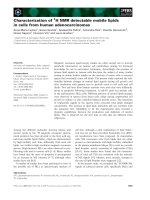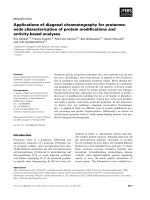Tài liệu Báo cáo khoa học: "SenseLearner: Word Sense Disambiguation for All Words in Unrestricted Text" doc
Bạn đang xem bản rút gọn của tài liệu. Xem và tải ngay bản đầy đủ của tài liệu tại đây (59.08 KB, 4 trang )
Proceedings of the ACL Interactive Poster and Demonstration Sessions,
pages 53–56, Ann Arbor, June 2005.
c
2005 Association for Computational Linguistics
SenseLearner: Word Sense Disambiguation
for All Words in Unrestricted Text
Rada Mihalcea and Andras Csomai
Department of Computer Science and Engineering
University of North Texas
,
Abstract
This paper describes SENSELEARNER – a
minimally supervised word sense disam-
biguation system that attempts to disam-
biguate all content words in a text using
WordNet senses. We evaluate the accu-
racy of SENSELEARNER on several stan-
dard sense-annotated data sets, and show
that it compares favorably with the best re-
sults reported during the recent SENSEVAL
evaluations.
1 Introduction
The task of word sense disambiguation consists of
assigning the most appropriate meaning to a polyse-
mous word within a given context. Applications such
as machine translation, knowledge acquisition, com-
mon sense reasoning, and others, require knowledge
about word meanings, and word sense disambiguation
is considered essential for all these applications.
Most of the efforts in solving this problem were
concentrated so far toward targeted supervised learn-
ing, where each sense tagged occurrence of a particu-
lar word is transformed into a feature vector, which is
then used in an automatic learning process. The appli-
cability of such supervised algorithms is however lim-
ited only to those few words for which sense tagged
data is available, and their accuracy is strongly con-
nected to the amount of labeled data available at hand.
Instead, methods that address all words in unre-
stricted text have received significantly less attention.
While the performance of such methods is usually
exceeded by their supervised lexical-sample alterna-
tives, they have however the advantage of providing
larger coverage.
In this paper, we present a method for solving the
semantic ambiguity of all content words in a text. The
algorithm can be thought of as a minimally supervised
word sense disambiguation algorithm, in that it uses
a relatively small data set for training purposes, and
generalizes the concepts learned from the training data
to disambiguate the words in the test data set. As a
result, the algorithm does not need a separate classi-
fier for each word to be disambiguated, but instead it
learns global models for general word categories.
2 Background
For some natural language processing tasks, such as
part of speech tagging or named entity recognition,
regardless of the approach considered, there is a con-
sensus on what makes a successful algorithm. Instead,
no such consensus has been reached yet for the task
of word sense disambiguation, and previous work has
considered a range of knowledge sources, such as lo-
cal collocational clues, common membership in se-
mantically or topically related word classes, semantic
density, and others.
In recent SENSEVAL-3 evaluations, the most suc-
cessful approaches for all words word sense disam-
biguation relied on information drawn from annotated
corpora. The system developed by (Decadt et al.,
2004) uses two cascaded memory-based classifiers,
combined with the use of a genetic algorithm for joint
parameter optimization and feature selection. A sep-
arate “word expert” is learned for each ambiguous
word, using a concatenated corpus of English sense-
53
New raw
text
Feature vector
construction
(POS, NE, MWE)
Preprocessing
Semantic model
learning
Sense−tagged
text
semantic models
SenseLearner
definitions
Word sense
disambiguation
Trained semantic
models
Sense−tagged
texts
Figure 1: Semantic model learning in SENSE-
LEARNER
tagged texts, including SemCor, SENSEVAL data sets,
and a corpus built from WordNet examples. The per-
formance of this system on the SENSEVAL-3 English
all words data set was evaluated at 65.2%.
Another top ranked system is the one developed by
(Yuret, 2004), which combines two Naive Bayes sta-
tistical models, one based on surrounding collocations
and another one based on a bag of words around the
target word. The statistical models are built based on
SemCor and WordNet, for an overall disambiguation
accuracy of 64.1%.
A different version of our own SENSELEARNER
system (Mihalcea and Faruque, 2004), using three of
the semantic models described in this paper, combined
with semantic generalizations based on syntactic de-
pendencies, achieved a performance of 64.6%.
3 SenseLearner
Our goal is to use as little annotated data as possi-
ble, and at the same time make the algorithm general
enough to be able to disambiguate as many content
words as possible in a text, and efficient enough so
that large amounts of text can be annotated in real
time. SENSELEARNER is attempting to learn general
semantic models for various word categories, starting
with a relatively small sense-annotated corpus. We
base our experiments on SemCor (Miller et al., 1993),
a balanced, semantically annotated dataset, with all
content words manually tagged by trained lexicogra-
phers.
The input to the disambiguation algorithm consists
of raw text. The output is a text with word meaning
annotations for all open-class words.
The algorithm starts with a preprocessing stage,
where the text is tokenized and annotated with part-of-
speech tags; collocations are identified using a sliding
window approach, where a collocation is defined as
a sequence of words that forms a compound concept
defined in WordNet (Miller, 1995); named entities are
also identified at this stage
1
.
Next, a semantic model is learned for all predefined
word categories, which are defined as groups of words
that share some common syntactic or semantic prop-
erties. Word categories can be of various granulari-
ties. For instance, using the SENSELEARNER learn-
ing mechanism, a model can be defined and trained to
handle all the nouns in the test corpus. Similarly, us-
ing the same mechanism, a finer-grained model can be
defined to handle all the verbs for which at least one
of the meanings is of type <move>. Finally, small
coverage models that address one word at a time, for
example a model for the adjective small, can be also
defined within the same framework. Once defined and
trained, the models are used to annotate the ambigu-
ous words in the test corpus with their corresponding
meaning. Section 4 below provides details on the vari-
ous models that are currently implemented in SENSE-
LEARNER, and information on how new models can
be added to the SENSELEARNER framework.
Note that the semantic models are applicable only
to: (1) words that are covered by the word category
defined in the models; and (2) words that appeared at
least once in the training corpus. The words that are
not covered by these models (typically about 10-15%
of the words in the test corpus) are assigned with the
most frequent sense in WordNet.
An alternative solution to this second step was sug-
gested in (Mihalcea and Faruque, 2004), using seman-
tic generalizations learned from dependencies identi-
fied between nodes in a conceptual network. Their
approach however, although slightly more accurate,
conflicted with our goal of creating an efficient WSD
system, and therefore we opted for the simpler back-
off method that employs WordNet sense frequencies.
1
We only identify persons, locations, and groups, which are
the named entities specifically identified in SemCor.
54
4 Semantic Models
Different semantic models can be defined and trained
for the disambiguation of different word categories.
Although more general than models that are built in-
dividually for each word in a test corpus (Decadt et
al., 2004), the applicability of the semantic models
built as part of SENSELEARNER is still limited to
those words previously seen in the training corpus,
and therefore their overall coverage is not 100%.
Starting with an annotated corpus consisting of all
annotated files in SemCor, a separate training data set
is built for each model. There are seven models pro-
vided with the current SENSELEARNER distribution,
implementing the following features:
4.1 Noun Models
modelNN1: A contextual model that relies on the first
noun, verb, or adjective before the target noun, and
their corresponding part-of-speech tags.
modelNNColl: A collocation model that implements
collocation-like features based on the first word to the
left and the first word to the right of the target noun.
4.2 Verb Models
modelVB1 A contextual model that relies on the first
word before and the first word after the target verb,
and their part-of-speech tags.
modelVBColl A collocation model that implements
collocation-like features based on the first word to the
left and the first word to the right of the target verb.
4.3 Adjective Models
modelJJ1 A contextual model that relies on the first
noun after the target adjective.
modelJJ2 A contextual model that relies on the first
word before and the first word after the target adjec-
tive, and their part-of-speech tags.
modelJJColl A collocation model that implements
collocation-like features using the first word to the left
and the first word to the right of the target adjective.
4.4 Defining New Models
New models can be easily defined and trained fol-
lowing the same SENSELEARNER learning method-
ology. In fact, the current distribution of SENSE-
LEARNER includes a template for the subroutine re-
quired to define a new semantic model, which can be
easily adapted to handle new word categories.
4.5 Applying Semantic Models
In the training stage, a feature vector is constructed
for each sense-annotated word covered by a semantic
model. The features are model-specific, and feature
vectors are added to the training set pertaining to the
corresponding model. The label of each such feature
vector consists of the target word and the correspond-
ing sense, represented as word#sense. Table 1 shows
the number of feature vectors constructed in this learn-
ing stage for each semantic model.
To annotate new text, similar vectors are created for
all content-words in the raw text. Similar to the train-
ing stage, feature vectors are created and stored sepa-
rately for each semantic model.
Next, word sense predictions are made for all test
examples, with a separate learning process run for
each semantic model. For learning, we are using the
Timbl memory based learning algorithm (Daelemans
et al., 2001), which was previously found useful for
the task of word sense disambiguation (Hoste et al.,
2002), (Mihalcea, 2002).
Following the learning stage, each vector in the test
data set is labeled with a predicted word and sense.
If several models are simultaneously used for a given
test instance, then all models have to agree in the la-
bel assigned, for a prediction to be made. If the word
predicted by the learning algorithm coincides with the
target word in the test feature vector, then the pre-
dicted sense is used to annotate the test instance. Oth-
erwise, if the predicted word is different than the tar-
get word, no annotation is produced, and the word is
left for annotation in a later stage.
5 Evaluation
The SENSELEARNER system was evaluated on the
SENSEVAL-2 and SENSEVAL-3 English all words
data sets, each data set consisting of three texts from
the Penn Treebank corpus annotated with WordNet
senses. The SENSEVAL-2 corpus includes a total of
2,473 annotated content words, and the SENSEVAL-
3 corpus includes annotations for an additional set
of 2,081 words. Table 1 shows precision and recall
figures obtained with each semantic model on these
two data sets. A baseline, computed using the most
frequent sense in WordNet, is also indicated. The
best results reported on these data sets are 69.0% on
SENSEVAL-2 data (Mihalcea and Moldovan, 2002),
55
Training SENSEVAL-2 SENSEVAL-3
Model size Precision Recall Precision Recall
modelNN1 88058 0.6910 0.3257 0.6624 0.3027
modelNNColl 88058 0.7130 0.3360 0.6813 0.3113
modelVB1 48328 0.4629 0.1037 0.5352 0.1931
modelVBColl 48328 0.4685 0.1049 0.5472 0.1975
modelJJ1 35664 0.6525 0.1215 0.6648 0.1162
modelJJ2 35664 0.6503 0.1211 0.6593 0.1153
modelJJColl 35664 0.6792 0.1265 0.6703 0.1172
model*1/2 207714 0.6481 0.6481 0.6184 0.6184
model*Coll 172050 0.6622 0.6622 0. 6328 0.6328
Baseline 63.8% 63.8% 60.9% 60.9%
Table 1: Precision and recall for the SENSELEARNER
semantic models, measured on the SENSEVAL-2 and
SENSEVAL-3 English all words data. Results for com-
binations of contextual (model*1/2) and collocational
(model*Coll) models are also included.
and 65.2% on SENSEVAL-3 data (Decadt et al., 2004).
Note however that both these systems rely on signifi-
cantly larger training data sets, and thus the results are
not directly comparable.
In addition, we also ran an experiment where a sep-
arate model was created for each individual word in
the test data, with a back-off method using the most
frequent sense in WordNet when no training exam-
ples were found in SEMCOR. This resulted into sig-
nificantly higher complexity, with a very large num-
ber of models (about 900–1000 models for each of
the SENSEVAL-2 and SENSEVAL-3 data sets), while
the performance did not exceed the one obtained with
the more general semantic models.
The average disambiguation precision obtained
with SENSELEARNER improves significantly over the
simple but competitive baseline that selects by de-
fault the “most frequent sense” from WordNet. Not
surprisingly, the verbs seem to be the most difficult
word class, which is most likely explained by the large
number of senses defined in WordNet for this part of
speech.
6 Conclusion
In this paper, we described and evaluated an efficient
algorithm for minimally supervised word-sense dis-
ambiguation that attempts to disambiguate all content
words in a text using WordNet senses. The results ob-
tained on both SENSEVAL-2 and SENSEVAL-3 data
sets are found to significantly improve over the sim-
ple but competitive baseline that chooses by default
the most frequent sense, and are proved competitive
with the best published results on the same data sets.
SENSELEARNER is publicly available for download
at />Acknowledgments
This work was partially supported by a National Sci-
ence Foundation grant IIS-0336793.
References
W. Daelemans, J. Zavrel, K. van der Sloot, and A. van den
Bosch. 2001. Timbl: Tilburg memory based learner,
version 4.0, reference guide. Technical report, Univer-
sity of Antwerp.
B. Decadt, V. Hoste, W. Daelemans, and A. Van den
Bosch. 2004. Gambl, genetic algorithm optimization of
memory-based wsd. In Senseval-3: Third International
Workshop on the Evaluation of Systems for the Semantic
Analysis of Text, Barcelona, Spain, July.
V. Hoste, W. Daelemans, I. Hendrickx, and A. van den
Bosch. 2002. Evaluating the results of a memory-based
word-expert approach to unrestricted word sense dis-
ambiguation. In Proceedings of the ACL Workshop on
”Word Sense Disambiguatuion: Recent Successes and
Future Directions”, Philadelphia, July.
R. Mihalcea and E. Faruque. 2004. SenseLearner: Min-
imally supervised word sense disambiguation for all
words in open text. In Proceedings of ACL/SIGLEX
Senseval-3, Barcelona, Spain, July.
R. Mihalcea and D. Moldovan. 2002. Pattern learning
and active feature selection for word sense disambigua-
tion. In Senseval 2001, ACL Workshop, pages 127–130,
Toulouse, France, July.
R. Mihalcea. 2002. Instance based learning with automatic
feature selection applied to Word Sense Disambiguation.
In Proceedings of the 19th International Conference on
Computational Linguistics (COLING 2002), Taipei, Tai-
wan, August.
G. Miller, C. Leacock, T. Randee, and R. Bunker. 1993.
A semantic concordance. In Proceedings of the 3rd
DARPA Workshop on Human Language Technology,
pages 303–308, Plainsboro, New Jersey.
G. Miller. 1995. Wordnet: A lexical database. Communi-
cation of the ACM, 38(11):39–41.
D. Yuret. 2004. Some experiments with a naive bayes wsd
system. In Senseval-3: Third International Workshop
on the Evaluation of Systems for the Semantic Analysis
of Text, Barcelona, Spain, July.
56




